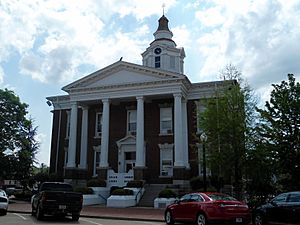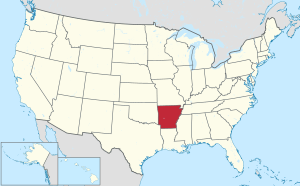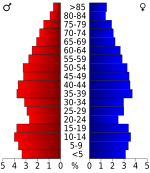Logan County, Arkansas facts for kids
Quick facts for kids
Logan County
|
|
|---|---|

Logan County Courthouse, Paris
|
|

Location within the U.S. state of Arkansas
|
|
 Arkansas's location within the U.S. |
|
| Country | |
| State | |
| Founded | March 22, 1871 |
| Named for | James Logan |
| Seat | Paris (northern district); Booneville (southern district) |
| Largest city | Booneville |
| Area | |
| • Total | 732 sq mi (1,900 km2) |
| • Land | 708 sq mi (1,830 km2) |
| • Water | 23 sq mi (60 km2) 3.2%% |
| Population
(2020)
|
|
| • Total | 21,131 |
| • Density | 28.867/sq mi (11.146/km2) |
| Time zone | UTC−6 (Central) |
| • Summer (DST) | UTC−5 (CDT) |
| Congressional district | 4th |
Logan County, once called Sarber County, is a county in the state of Arkansas. In 2020, about 21,131 people lived there. It has two main towns where the county government is located: Booneville and Paris.
Contents
History of Logan County
The state of Arkansas created its 64th county on March 22, 1871. It was made from parts of Scott, Yell, and Pope counties. Later, a part of Franklin County was also added.
How Sarber County Got Its Name
The county was first named Sarber County. It was named after John Newton Sarber (1837–1905). He was a lawyer and a state senator from Yell County. Sarber had suggested the idea to create the county. He was born in Pittsburgh, Pennsylvania, and moved to Kansas in 1855.
Sarber was important in the Arkansas government. He helped start the state's first public school system. He also helped create what is now the University of Arkansas. In 1873, Sarber became a U.S. marshal in Fort Smith.
Why the Name Changed
Some people didn't like Sarber because he had fought for the Union Army during the Civil War. They called him a "carpetbagger." This was a name for Northerners who moved South after the war. Sarber married Susan Rebecca Rose in 1867. She was the daughter of an early settler who supported the Confederacy.
In 1875, a new group of leaders took control of the state government. They decided to change the county's name. They renamed it Logan County after James Logan (1792-1859). He was an early settler from Kentucky. Logan had served in the state government when Arkansas was still a territory. He also served in the first state legislature.
Geography of Logan County
Logan County covers about 732 square miles (1,896 square kilometers). Most of this area, about 708 square miles (1,834 square kilometers), is land. The rest, about 23 square miles (60 square kilometers), is water.
The tallest natural point in Arkansas is in Logan County. It is called Magazine Mountain. It stands at 2,753 feet (839 meters) high.
Main Roads
 Highway 10
Highway 10 Highway 22
Highway 22 Highway 23
Highway 23 Highway 60
Highway 60 Highway 309
Highway 309
Neighboring Counties
- Johnson County (north)
- Pope County (northeast)
- Yell County (southeast)
- Scott County (south)
- Sebastian County (west)
- Franklin County (northwest)
People of Logan County (Demographics)
| Historical population | |||
|---|---|---|---|
| Census | Pop. | %± | |
| 1880 | 14,885 | — | |
| 1890 | 20,774 | 39.6% | |
| 1900 | 20,563 | −1.0% | |
| 1910 | 26,350 | 28.1% | |
| 1920 | 25,866 | −1.8% | |
| 1930 | 24,110 | −6.8% | |
| 1940 | 25,967 | 7.7% | |
| 1950 | 20,260 | −22.0% | |
| 1960 | 15,957 | −21.2% | |
| 1970 | 16,789 | 5.2% | |
| 1980 | 20,144 | 20.0% | |
| 1990 | 20,557 | 2.1% | |
| 2000 | 22,486 | 9.4% | |
| 2010 | 22,353 | −0.6% | |
| 2020 | 21,131 | −5.5% | |
| 2023 (est.) | 21,400 | −4.3% | |
| U.S. Decennial Census 1790–1960 1900–1990 1990–2000 2010 |
|||
2020 Census Information
In 2020, the United States Census counted 21,131 people living in Logan County. There were 8,417 households and 5,839 families.
The table below shows the different groups of people living in Logan County in 2020.
| Race | Number | Percentage |
|---|---|---|
| White (not Hispanic) | 18,586 | 87.96% |
| Black or African American (not Hispanic) | 225 | 1.06% |
| Native American | 228 | 1.08% |
| Asian | 328 | 1.55% |
| Pacific Islander | 8 | 0.04% |
| Other/Mixed | 1,116 | 5.28% |
| Hispanic or Latino | 640 | 3.03% |
Communities in Logan County
Logan County has several towns and communities.
Cities
- Booneville (a county seat)
- Magazine
- Paris (a county seat)
- Ratcliff
- Scranton
Towns
Census-designated place
Unincorporated communities
These are smaller places that are not officially cities or towns.
Townships
Townships in Arkansas are the divisions of a county. Each township includes unincorporated areas; some may have incorporated cities or towns within part of their boundaries. Arkansas townships have limited purposes in modern times. However, the United States Census does list Arkansas population based on townships (sometimes referred to as "county subdivisions" or "minor civil divisions"). Townships are also of value for historical purposes in terms of genealogical research. Each town or city is within one or more townships in an Arkansas county based on census maps and publications. The townships of Logan County are listed below; listed in parentheses are the cities, towns, and/or census-designated places that are fully or partially inside the township.
- Barber
- Blue Mountain (Blue Mountain)
- Boone (Booneville)
- Cane Creek
- Cauthron
- Clark (Subiaco)
- Delaware
- Driggs
- Ellsworth
- Johnson
- Logan
- Mountain
- Petit Jean
- Reveilee (Magazine)
- River (Morrison Bluff, Scranton)
- Roseville
- Shoal Creek (CDP New Blaine)
- Short Mountain (Paris)
- Six Mile (Caulksville, Ratcliff)
- Sugar Creek
- Tomlinson
- Washburn
Famous People from Logan County
Many interesting people have lived in or come from Logan County.
- Katharine Anthony, an American writer who wrote biographies.
- James Bridges, born in Paris, Arkansas, a famous screenwriter and film director.
- Dizzy Dean, born in Lucas, Arkansas, a well-known major league baseball player.
- Paul Dean, also born in Lucas, Arkansas, was Dizzy Dean's brother and also a major league baseball player.
- Jon Eubanks, a Republican member of the Arkansas House of Representatives from Paris, Arkansas. He is a farmer and an accountant.
- General John P. McConnell, who was the Chief of Staff for the U.S. Air Force.
- Robert Johnson, a famous blues musician, lived in Lucas, Arkansas, around 1920.
See also
 In Spanish: Condado de Logan (Arkansas) para niños
In Spanish: Condado de Logan (Arkansas) para niños


